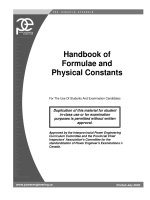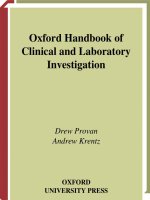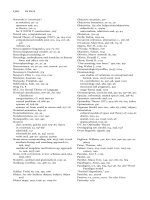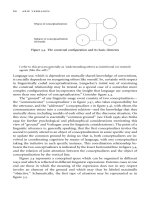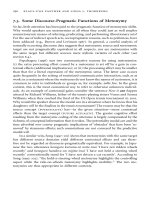Oxford Handbook of Clinical and Laboratory Investigation pdf
Bạn đang xem bản rút gọn của tài liệu. Xem và tải ngay bản đầy đủ của tài liệu tại đây (12.45 MB, 626 trang )
Oxford Handbook of
Clinical and Laboratory
Investigation
Drew Provan
Andrew Krentz
OXFORD
UNIVERSITY PRESS
OXFORD MEDICAL PUBLICATIONS
Oxford Handbook of
Clinical and
Laboratory
Investigation
01OHCI-PRE(i-xxiv) 8/10/02 10:04 AM Page i
Oxford University Press makes no representation, express or implied, that
the drug dosages in this book are correct. Readers must therefore always
check the product information and clinical procedures with the most up-
to-date published product information and data sheets provided by the
manufacturers and the most recent codes of conduct and safety regula-
tions. The authors and the publishers do not accept responsibility or legal
liability for any errors in the text or for the misuse or misapplication of
material in this work.
i Except where otherwise stated, drug doses and recommendations
are for the non-pregnant adult who is not breast-feeding.
01OHCI-PRE(i-xxiv) 8/10/02 10:04 AM Page ii
Oxford Handbook of
Clinical and
Laboratory
Investigation
Drew Provan
Senior Lecturer in Haematology,
St Bartholomew’s and The Royal London Hospital
School of Medicine & Dentistry, London,
UK
Andrew Krentz
Honorary Senior Lecturer in Medicine,
Southampton University Hospitals
NHS
Trust,
Southampton,
UK
1
01OHCI-PRE(i-xxiv) 8/10/02 10:05 AM Page iii
1
Great Clarendon Street, Oxford OX2 6DP
Oxford New York
Auckland Bangkok Buenos Aires
Cape Town Chennai Dar es Salaam Delhi Hong Kong Istanbul
Karachi Kolkata Kuala Lumpur Madrid Melbourne Mexico City Mumbai
Nairobi Paris São Paolo Singapore Taipei Tokyo Toronto
Oxford is a trade mark of Oxford University Press
Published in the United States
by Oxford University Press, Inc., New York
© Oxford University Press 2002
The moral rights of the author have been asserted
First published 2002
All rights reserved. No part of this publication may be reproduced,
stored in a retrieval system, or transmitted, in any form or by any means,
without the prior permission in writing of Oxford University Press.
Within the UK, exceptions are allowed in respect of any fair dealing for the
purpose of research or private study, or criticism or review, as permitted
under the Copyright, Designs and Patents Act, 1988, or in the case of
reprographic reproduction in accordance with the terms of licences
issued by the Copyright Licensing Agency. Enquiries concerning
reproduction outside those terms and in other countries should be sent to
the Rights Department, Oxford University Press,
at the address above.
This book is sold subject to the condition that it shall not, by way
of trade or otherwise, be lent, re-sold, hired out, or otherwise circulated
without the publisher’s prior consent in any form of binding or cover
other than that in which it is published and without a similar condition
including this condition being imposed on the subsequent purchaser.
British Library Cataloguing in Publication Data
Data available
Library of Congress Cataloging in Publication Data
1 3 5 7 9 10 8 6 4 2
ISBN 0 19 263283 3
Typeset by Drew Provan and
EXPO
Holdings, Malaysia
Printed in Great Britain on acid free paper by The Bath Press, Avon,
UK
01OHCI-PRE(i-xxiv) 8/10/02 10:05 AM Page iv
Contents
3
99
165
241
257
303
325
355
383
423
459
487
495
539
583
Contributors
vi
Foreword by Professor Sir George Alberti
viii
Preface
ix
Acknowledgements
x
Symbols & abbreviations
xi
Introduction: Approach to investigations
xix
Part 1 The patient
1 Symptoms and signs
Part 2 Investigations
2 Endocrinology and metabolism
3 Haematology
4 Immunology
5 Infectious & tropical diseases
6 Cardiology
7 Gastroenterology
8 Respiratory medicine
9 Neurology
10 Renal medicine
11 Poisoning and overdose
12 Rheumatology
13 Radiology
14 Nuclear medicine
15 Normal ranges
Index
585
01OHCI-PRE(i-xxiv) 8/10/02 10:06 AM Page v
vi
Contributors
John Axford
Reader in Medicine, Academic
Unit for Musculoskeletal Disease,
Department of Immunology, St
George’s Hospital Medical School,
London SW17 0RE
Immunology & rheumatology
Martyn Bracewell
Lecturer in Neurology,
Department of Neurology, The
Queen Elizabeth Hospital,
Birmingham B15 2TH
Neurology
Joanna Brown
Clinical Research Fellow,
University of Southampton, School
of Medicine,
RCMB
Division,
Southampton SO16 6YD
Respiratory medicine
Tanya Chawla
Specialist Registrar in Radiology,
Department of Radiology,
Southampton University Hospitals
NHS Trust, Southampton SO16
6YD
Radiology
Keith Dawkins
Consultant Cardiologist, Wessex
Cardiology Unit, Southampton
University Hospitals NHS Trust,
Southampton SO16 6YD
Cardiology
Colin Dayan
Consultant Senior Lecturer in
Medicine, Division of Medicine
Laboratories, Bristol Royal
Infirmary, Bristol BS2 8BX
Endocrinology & metabolism
Tony Frew
Professor of Medicine, University
of Southampton, School of
Medicine,
RCMB
Division,
Southampton SO16 6YD
Respiratory medicine
Stephen T. Green
Consultant Physician and
Honorary Senior Clinical Lecturer,
Department of
Infection & Tropical
Medicine, Royal Hallamshire
Hospital, Sheffield S10 2JF
Infectious & tropical diseases
Alison Jones
Consultant Physician and Clinical
Toxicologist, Medical Toxicology
Unit, Guy’s & St Thomas’ Hospital,
London SE14 5ER.
Poisoning & overdose
Andrew Krentz
Consultant in Diabetes &
Endocrinology and Honorary
Senior Lecturer in Medicine,
Department of Medicine,
Southampton University Hospitals
NHS Trust, Southampton SO16
6YD
Endocrinology & metabolism
Val Lewington
Consultant in Nuclear Medicine,
Department of Nuclear Medicine,
Southampton University Hospitals
NHS Trust, Southampton SO16
6YD
Nuclear medicine
01OHCI-PRE(i-xxiv) 8/10/02 10:08 AM Page vi
vii
Praful Patel
Consultant Gastroenterologist,
Department of Gastroenterology,
Southampton University Hospitals
NHS Trust, Southampton SO16
6YD
Gastroenterology
Drew Provan
Senior Lecturer, Department of
Haematology, St Bartholomew’s &
The Royal London School of
Medicine & Dentistry, London E1
1BB
Haematology, transfusion & cyto-
genetics
Rommel Ravanan
Specialist Registrar, The Richard
Bright Renal Unit, Southmead
Hospital, Westbury-on-Trym,
Bristol BS10 5NB
Renal medicine
Charlie Tomson
Consultant Nephrologist, The
Richard Bright Renal Unit,
Southmead Hospital, Westbury-
on-Trym, Bristol BS10 5NB
Renal medicine
Ken Tung
Consultant Radiologist,
Department of Radiology,
Southampton University Hospitals
NHS Trust, Southampton SO16
6YD
Radiology
Adrian Williams
Professor of Neurology,
Department of Neurology, The
Queen Elizabeth Hospital,
Birmingham B15 2TH
Neurology
Lorraine Wilson
Senior Registrar, Department of
Nuclear Medicine, Southampton
University Hospitals NHS Trust,
Southampton SO16 6YD
Nuclear medicine
Dr Tanay Sheth
Specialist Registrar in
Gastroenterology, Southampton
University Hospitals NHS Trust,
UK
Our registrars
We are indebted to our juniors
for writing and checking various
sections, in particular Symptoms &
signs.
Southampton University Hospitals:
Martin Taylor, Michael Masding,
Mayank Patel, Ruth Poole and
Catherine Talbot.
St Bartholomew’s & The Royal
London School of Medicine &
Dentistry: Simon Stanworth, Jude
Gaffan, Leon Clark and Nikki Curry.
Contributors
01OHCI-PRE(i-xxiv) 8/10/02 10:10 AM Page vii
viii
This book fills an obvious gap in the Handbook series and indeed a major
lacuna in the medical literature. Too often investigations of a particular
condition are lost in the welter of other text. Alternatively, they appear as
specialist books in pathology and radiology. One unique feature of this
book is the inclusion of all clinical investigative techniques, i.e. both truly
clinical tests in the shape of symptoms and signs and then laboratory-
based investigations. This stops what is often an artificial separation. Each
section is clearly put together with the intent of easing rapid reference.
This is essential if the book is to have (and I believe it does have) real use-
fulness for bedside medicine. There are many other useful aspects of the
text. These include a comprehensive list of abbreviations—the bugbear of
medicine, as well as reference ranges which some laboratories still do not
append to results. Overall, the Handbook should be of benefit to not just
clinical students and junior doctors in training, but all who have patient
contact. With this in one pocket, and Longmore in the other, there should
be little excuse for errors in diagnosis and investigation, with the added
benefit that the balance between the two will allow the upright posture to
be maintained.
Professor Sir George Alberti
President of The Royal College of Physicians of London
July 2002
Foreword
01OHCI-PRE(i-xxiv) 8/10/02 10:10 AM Page viii
ix
Preface
With the increasing complexity of modern medicine, we now have literally
thousands of possible investigative techniques at our disposal. We are able
to examine our patient’s serum and every other body fluid down to the
level of individual nucleotides, as well as being able to perform precise
imaging through
CT, MRI
and other imaging technologies. The problem we
have all faced, especially as senior medical students or junior doctors is:
which test should we use in a given setting? What hazards are associated
with the tests? Are there any situations where specific tests should not be
used or are likely to produce erroneous results? As medical complexity
increases so too does cost; many assays available today are highly expen-
sive and wherever possible we would ideally like to use a test which is
cheap, reliable, reproducible and right for a given situation.
Such knowledge takes many years to acquire and it is a fact of life that
senior doctors (who have attained such knowledge) are not usually those
who request the investigations. In this small volume, we have attempted
to distil all that is known about modern tests, from blood, urine and other
body fluids, along with imaging and molecular tests. The book is divided
into two principal parts: the first deals with symptoms and signs in The
patient section, because that is how patients present. We have tried to
cover as many topics as possible, discussing these in some detail and have
provided differential diagnoses where possible. We also try to suggest
tests that might be of value in determining the cause of the patient’s
symptom or sign. The second part of the book, Investigations, is spe-
cialty-specific, and is more relevant once you know roughly what type of
disease the patient might have. For example, if the symptom section sug-
gests a likely respiratory cause for the patient’s symptoms, then the reader
should look to the Respiratory investigations chapter in order to determine
which tests to carry out, or how to interpret the results.
The entire book is written by active clinicians, rather than scientists, since
we wanted to provide a strong clinical approach to investigation. We have
tried, wherever possible, to cross-refer to the Oxford Handbook of Clinical
Medicine, 5th edition, Oxford University Press, which provides the clinical
detail omitted from this handbook. The symbol is used to highlight a
cross-reference to
OHCM
, in addition to cross-referencing within this book.
We would value feedback from readers since there will doubtless be
tests omitted, errors in the text and many other improvements we could,
and will, make in future editions. All contributors will be acknowledged
individually in the next edition. We would suggest you e-mail us directly:
Drew Provan
Andrew Krentz
2002
01OHCI-PRE(i-xxiv) 8/10/02 10:11 AM Page ix
Even small books such as this rely on the input of many people, besides
the main editors and we are indebted to many of our colleagues for pro-
viding helpful suggestions and for proofreading the text. Dr Barbara Bain,
St Mary’s Hospital, London, kindly allowed us to peruse the proofs of
Practical Haematology, 9th edition (Churchill Livingstone) to help make
sure the haematology section was up to date. Dr Debbie Lillington,
Department of Cytogenetics, Barts & The London NHS Trust, London,
provided invaluable cytogenetic advice. Our registrars have had input into
many sections and we thank the London registrars: Simon Stanworth, Jude
Gaffan, Leon Clark and Nikki Curry, and the Southampton registrars:
Fiona Clark, Michael Masding, Mayank Patel, Ruth Poole and Catherine
Talbot.
Dr Murray Longmore, the undisputed Oxford Handbook king, has pro-
vided invaluable wisdom and has very kindly allowed us to use his specially
designed
OHCM
typeface (
OUP
) for many of the symbols in our text.
Murray also provided page proofs of the
OHCM,
5th edition, which was
invaluable for cross-referencing this handbook.
Warm thanks are also extended to Oxford University Press, and in par-
ticular Esther (Browning) who first commissioned the book. Very special
thanks must go to Catherine (Barnes), commissioning editor for medicine,
who has stuck with the project, and most likely has aged 10 years as a
result of it! She has provided constant encouragement and helped keep us
sane throughout the entire process (well, almost sane). Katherine Sugg
and Victoria Oddie relentlessly chased up missing artwork, text and gen-
erally kept the project moving.
x
Acknowledgements
01OHCI-PRE(i-xxiv) 8/10/02 10:11 AM Page x
xi
Symbols &
abbreviations
cross-reference to
OHCM
5th edition, or section of this
book
i important
ii very important
5 decreased
4 increased
6 normal
9 : 3 male : female ratio
1° primary
2° secondary
A&E
accident & emergency
AAFB
acid and alcohol fast bacilli
A
b antibody
ABG
s arterial blood gases
ACD
anaemia of chronic disease
ACE
angiotensin converting enzyme
AC
h acetylcholine
ACL
anticardiolipin antibody
ACR
acetylcholine receptor
ACS
acute coronary syndrome
ADA
American Diabetes Association
ADH
antidiuretic hormone
ADP
adenosine 5-diphosphate
AECG
ambulatory
ECG
AF
atrial fibrillation
A
g antigen
AIDS
acquired immunodeficiency syndrome
AIHA
autoimmune haemolytic anaemia
AKA
alcoholic ketoacidosis
ALL
acute lymphoblastic leukaemia
ALP
alkaline phosphatase
ALT
alanine aminotransferase
AMI
acute myocardial infarction
AML
acute myeloid leukaemia
ANA
antinuclear antibodies
01OHCI-PRE(i-xxiv) 8/10/02 10:12 AM Page xi
ANAE
alpha naphthyl acetate esterase
ANCA
antineutrophil cytoplasmic antibody
ANF
antinuclear factor
APCR
activated protein C resistance
APL
antiphospholipid antibody
APML
acute promyelocytic leukaemia
APS
antiphospholipid syndrome
APTR
activated partial thromboplastin time ratio
APTT
activated partial thromboplastin time
ARF
acute renal failure
AT
(
AT
III) antithrombin III
ATLL
adult T cell leukaemia/lymphoma
ATP
adenosine triphosphate
AXR
abdominal x-ray
BBB
blood–brain barrier
B-CLL
B-cell chronic lymphocytic leukaemia
bd bis die (twice daily)
BJP
Bence-Jones protein
BM
bone marrow
BMJ
British Medical Journal
BMT
bone marrow transplant(ation)
BP
blood pressure
B
x biopsy
C
1
INH
C1 esterase inhibitor
C
3Nef complement C3 nephritic factor
C&S
culture & sensitivity
Ca carcinoma
Ca
2+
calcium
CABG
coronary artery bypass graft
CAH
congenital adrenal hyperplasia
c
ALL
common acute lymphoblastic leukaemia
CBC
complete blood count (American term for FBC)
CCF
congestive cardiac failure
CCK
cholecystokinin
CCU
coronary care unit
CD
cluster designation
c
DNA
complementary DNA
CEA
carcinoembryonic antigen
CF
cystic fibrosis or complement fixation
cfu colony-forming units
CGL
chronic granulocytic leukaemia
CHAD
cold haemagglutinin disease
xii
01OHCI-PRE(i-xxiv) 8/10/02 10:13 AM Page xii
Symbols & abbreviations
xiii
CHD
coronary heart disease
CJD
Creutzfeldt-Jacob disease (v = new variant)
CK
creatine kinase
CL
–
chloride
CLL
chronic lymphocytic (‘lymphatic’) leukaemia
CLO
test Campylobacter-like organism
CML
chronic myeloid leukaemia
CMML
chronic myelomonocytic leukaemia
CMV
cytomegalovirus
CNS
central nervous system
CO
2
carbon dioxide
COPD
chronic obstructive pulmonary disease
CPAP
continuous positive airways pressure
CREST
calcinosis, Raynaud’s syndrome, (o)esophageal motility
dysfunction, sclerodactyly and telangiectasia
CRF
chronic renal failure
CRP
C-reactive protein
CSF
cerebrospinal fluid
CT
computed tomography
CTL
p cytotoxic T lymphocyte precursor assay
CVA
cerebrovascular accident (stroke)
CVD
cardiovascular disease
CVS
cardiovascular system or chorionic villus sampling
CXR
chest x-ray
DAT
direct antiglobulin test
d
ATP
deoxy ATP
DCCT
Diabetes Control and Complications Trial
DCT
direct Coombs’ test
DDAVP
desamino D-arginyl vasopressin
DE
evoked potential
DIC
disseminated intravascular coagulation
DIDMOAD
diabetes insipidus, diabetes mellitus, optic atrophy and
deafness
DKA
diabetic ketoacidosis
dL decilitre
DM
diabetes mellitus
DNA
deoxyribonucleic acid
2,3-
DPG
2,3-diphosphoglycerate
d
RVVT
dilute Russell’s viper venom test
01OHCI-PRE(i-xxiv) 8/10/02 10:13 AM Page xiii
DTT
dilute thromboplastin time
DU
duodenal ulcer
DVT
deep vein thrombosis
DXT
radiotherapy
EBV
Epstein-Barr virus
ECG
electrocardiograph
EDH
extradural haemorrhage
EDTA
ethylenediamine tetraacetic acid
EEG
electroencephalogram
ELISA
enzyme-linked immunosorbent assay
EMG
electromyogram
Epo erythropoietin
ERCP
endoscopic retrograde cholangiopancreatography
ESR
erythrocyte sedimentation rate
ESREF
end-stage renal failure
ET
essential thrombocythaemia
et
OH
ethanol
FAB
French–American–British
FACS
fluorescence-activated cell sorter
FBC
full blood count (aka complete blood count, CBC)
FDP
s fibrin degradation products
Fe iron
FeSO
4
ferrous sulphate
FISH
fluorescence in situ hybridisation
FIX
factor IX
fL femtolitres
FMRI
functional MRI
FOB
faecal occult blood
FPG
fasting plasma glucose
FUO
fever of unknown origin (like PUO)
FV
III factor VIII
FVL
factor V Leiden
g gram
G&S
group & save serum
GAD
glutamic acid decarboxylase
␥
GT
␥-glutamyl transpeptidase
GBM
glomerular basement membrane
GIT
gastrointestinal tract
GPC
gastric parietal cell
G
6
PD
glucose-6-phosphate dehydrogenase
GPI
general paralysis of the insane
GTN
glyceryl trinitrate
GU
gastric ulcer
xiv
01OHCI-PRE(i-xxiv) 8/10/02 10:14 AM Page xiv
Symbols & abbreviations
xv
G
v
HD
graft versus host disease
h hour
HAV
hepatitis A virus
Hb haemoglobin
HbA haemoglobin A (␣
2

2
)
HbA
1c
haemoglobin A
1c
HbA
2
haemoglobin A
2
(␣
2
␦
2
)
HbF haemoglobin F (fetal Hb, ␣
2
␥
2
)
HbH haemoglobin H (
4
)
HBsAg hepatitis B surface antigen
HBV
hepatitis B virus
h
CG
human chorionic gonadotrophin
HCO
3
–
bicarbonate
Hct haematocrit
HCV
hepatitis C virus
HDN
haemolytic disease of the newborn
HE
hereditary elliptocytosis
HELLP
haemolysis, elevated liver enzymes and low platelet
count
HIV
human immunodeficiency virus
HLA
human leucocyte antigen
HNA
heparin neutralising activity
HONK
hyperosmolar non-ketotic syndrome
HPA
human platelet antigen
HPFH
hereditary persistence of fetal haemoglobin
HPLC
high-performance liquid chromatography
HPOA
hypertrophic pulmonary osteoarthropathy
HPP
hereditary pyropoikilocytosis
HTLV
human T-lymphotropic virus
IAGT
or
IAT
indirect antiglobulin test
IBS
irritable bowel syndrome
ICA
islet cell antibodies
ICH
intracranial haemorrhage
IDA
iron deficiency anaemia
IDDM
insulin dependent (type 1) diabetes mellitus
IEF
isoelectric focusing
IFG
impaired fasting glucose
IFN
-␣ interferon alpha
IGT
impaired glucose tolerance
IHD
ischaemic heart disease
01OHCI-PRE(i-xxiv) 8/10/02 10:15 AM Page xv
Ig immunoglobulin
IgA immunoglobulin A
IgD immunoglobulin D
IgE immunoglobulin E
IgG immunoglobulin G
IgM immunoglobulin M
IIF
indirect immunofluorescence
IM
intramuscular
INR
international normalized ratio
ITP
idiopathic thrombocytopenic purpura
ITU
intensive therapy unit
iu/IU international units
IV
intravenous
IVI
intravenous infusion
IVU
intravenous urogram
JCA
juvenile chronic arthritis
JVP
jugular venous pressure
K
+
potassium
KCCT
kaolin cephalin clotting time (≡
APTT
)
kDa kiloDaltons
kg kilogram
KUB
kidney, ureter, bladder (x-ray)
L litre or left
LA
lupus anticoagulant or lactic acidosis or local anaesthetic
LAP
leucocyte alkaline phosphatase (score)
LBBB
left bundle branch block
LCM
left costal margin
LDH
lactate dehydrogenase
LFT
s liver function tests
LIF
left iliac fossa
LKM
liver/kidney microsomal
LP
lumbar puncture
LUQ
left upper quadrant
LVF
left ventricular failure
LVH
left ventricular hypertrophy
MAG
myelin-associated glycoprotein
MAIPA
monoclonal antibody immobilisation of platelet antigens
MAOI
monoamine oxidase inhibitor
MC&S
microscopy, culture & sensitivity
MCH
mean cell haemoglobin
MCHC
mean corpuscular haemoglobin concentration
MCV
mean cell volume
xvi
01OHCI-PRE(i-xxiv) 8/10/02 10:15 AM Page xvi
Symbols & abbreviations
xvii
MDS
myelodysplastic syndrome
MELAS
myelopathy, encephalopathy, lactic acidosis and stroke-
like episodes
mg milligram (10
–3
gram)
MGUS
monoclonal gammopathy of undetermined significance
MHC
major histocompatibility complex
MI
myocardial infarction
min minutes
MoAb monoclonal antibody
MODY
maturity onset diabetes of the young
mOsm milliosmole
MPD
myeloproliferative disease
MPV
mean platelet volume
MRI
magnetic resonance imaging
m
RNA
messenger ribonucleic acid
MS
multiple sclerosis or mass spectroscopy
MSU
mid-stream urine
MTP
metatarsophalangeal
MUD
matched unrelated donor (transplant)
µg microgram (10
–6
gram)
Na
+
sodium
NaCl sodium chloride
NADP
nicotinamide adenine diphosphate
NADPH
nicotinamide adenine diphosphate (reduced)
NAP
neutrophil alkaline phosphatase
NEJM
New England Journal of Medicine
NH
3
ammonia
NHL
non-Hodgkin’s lymphoma
NRBC
nucleated red blood cells
NSAID
s non-steroidal anti-inflammatory drugs
NSTEMI
non-ST-elevation myocardial infarction
OA
osteoarthritis
OCP
oral contraceptive pill
od omni die (once daily)
OGD
oesophagogastroduodenoscopy
OGTT
oral glucose tolerance test
OHCH
Oxford Handbook of Clinical Haematology
OHCM
Oxford Handbook of Clinical Medicine
PA
posteroanterior or pernicious anaemia or pulmonary
artery
01OHCI-PRE(i-xxiv) 8/10/02 10:16 AM Page xvii
PACWP
pulmonary artery capillary wedge pressure
PAD
peripheral arterial disease
PAN
polyarteritis nodosa
PaO
2
partial pressure of O
2
in arterial blood
PAS
periodic acid-Schiff
PB
peripheral blood
PBC
primary biliary cirrhosis
PC
protein C or provocation concentration
PCH
paroxysmal cold haemoglobinuria
PCI
percutaneous coronary intervention
PCL
plasma cell leukaemia
PCP
Pneumocystis carinii pneumonia
PCR
polymerase chain reaction
PCT
proximal convoluted tubule
PCV
packed cell volume
PDA
patent ductus arteriosus
PE
pulmonary embolism
PEFR
peak expiratory flow rate
PET
positron emission tomography
Ph Philadelphia chromosome
PIFT
platelet immunofluorescence test
PK
pyruvate kinase
PO per os (by mouth)
PO
3–
4
phosphate
PR
per rectum
PRL
prolactin
PRV
polycythaemia rubra vera
PS
protein S or Parkinson’s syndrome
PSA
prostate-specific antigen
PT
prothrombin time
PV
plasma volume
qds quater die sumendus (to be taken 4 times a day)
RA
refractory anaemia or rheumatoid arthritis
RAS
renal angiotensin system or renal artery stenosis
RBBB
right bundle branch block
RBC
s red blood cells
RCC
red blood cell count
RDW
red cell distribution width
Rh Rhesus
RhF rheumatoid factor
RIA
radioimmunoassay
RiCoF ristocetin cofactor
xviii
01OHCI-PRE(i-xxiv) 8/10/02 10:17 AM Page xviii
Symbols & abbreviations
xix
RIF
right iliac fossa
RIPA
ristocetin-induced platelet aggregation
RNP
ribonucleoprotein
RPGN
rapidly progressive glomerulonephritis
RT-PCR
reverse transcriptase polymerase chain reaction
RUQ
right upper quadrant
s seconds
SAECG
signal-averaged
ECG
SAH
subarachnoid haemorrhage
SC
subcutaneous
SCA
sickle cell anaemia
SCD
sickle cell disease
SDH
subdural haemorrhage
SHBG
sex-hormone-binding globulin
SLE
systemic lupus erythematosus
SmIg surface membrane immunoglobulin
SOB
short of breath
SOL
space-occupying lesion
SM
smooth muscle
SPECT
single photon emission computed tomography
stat statim (immediate; as initial dose)
STEMI ST
-elevation myocardial infarction
sTfR soluble transferrin receptor assay
SVC
superior vena cava
SVCO
superior vena caval obstruction
SXR
skull x-ray
T° temperature
t
1
/
2
half-life
T4 thyroxine
TA
temporal arteritis
TB
tuberculosis
tds ter die sumendum (to be taken 3 times a day)
TdT terminal deoxynucleotidyl transferase
TENS
transcutaneous nerve stimulation
TFT
thyroid function test(s)
TIA
s transient ischaemic attacks
TIBC
total iron binding capacity
TN
trigeminal neuralgia
TNF
tumour necrosis factor
01OHCI-PRE(i-xxiv) 8/10/02 10:18 AM Page xix
TOE
transoesophageal echocardiogram
TPA
tissue plasminogen activator
TPO
thyroid peroxidase
TRAB
thyrotropin receptor antibodies
TRALI
transfusion-associated lung injury
TRAP
tartrate-resistant acid phosphatase
TSH
thyroid-stimulating hormone
TT
thrombin time
TTE
transthoracic echocardiography
TTP
thrombotic thrombocytopenic purpura
TXA
tranexamic acid
u/U units
UC
ulcerative colitis
U&E
urea and electrolytes
UKPDS
United Kingdom Prospective Diabetes Study
URTI
upper respiratory tract infection
UTI
urinary tract infection
USS
ultrasound scan
VIII:C factor VIII clotting activity
VIP
vasoactive intestinal peptide
Vit K vitamin K
VSD
ventricular septal defect
VTE
venous thromboembolism
v
WD
von Willebrand’s disease
v
WF
von Willebrand factor
v
WFA
g von Willebrand factor antigen
WBC
white blood count or white blood cells
WHO
World Health Organisation
WM
Waldenström’s macroglobulinaemia
XDP
s cross-linked fibrin degradation products
xx
01OHCI-PRE(i-xxiv) 8/10/02 10:18 AM Page xx
Introduction
Approach to investigation
xxi
Why do tests?
Patients seldom present to their doctors with diagnoses—rather, they
have symptoms or signs. The major challenge of medicine is being able to
talk to the patient and obtain a history and then carry out a physical exam-
ination looking for pointers to their likely underlying problem. Our elders
and, some would argue, betters in medicine had less tests available to
them then we have today, and their diagnoses were often made solely
from the history and examination. Of course, they would claim that their
clinical acumen and skills were greater than ours and that we rely too
heavily on the huge armoury of laboratory and other investigations avail-
able today. This, in part, is probably true, but we cannot ignore the fact
that advances in science and technology have spawned a bewildering array
of very useful and sophisticated tests that help us to confirm our diag-
nostic suspicions.
By ‘test’ we mean the measurement of a component of blood, marrow
or other body fluid or physiological parameter to determine whether the
patient’s value falls within or outside the normal range, either suggesting
the diagnosis or, in some cases, actually making the diagnosis for us.
Factors affecting variable parameters in health
Many measurable body constituents vary throughout life. For example, a
newborn baby has an extremely high haemoglobin concentration which
falls after delivery; this is completely normal and is physiological rather than
pathological. A haemoglobin level this high in an adult would be patholog-
ical since it is far outside the normal range for the adult population.
Reference ranges (normal values)
These are published for most measurable components of blood and other
tissue and we have included the normal ranges for most blood and
CSF
analytes at the end of the book.
Factors affecting measurable variables
2
Age.
2
Sex.
2
Ethnicity.
2
Altitude.
2
Build.
2
Physiological conditions (e.g. at rest, after exercise, standing, lying).
2
Sampling methods (e.g. with or without using tourniquet).
2
Storage and age of sample.
2
Container used, e.g. for blood sample, as well as anticoagulant.
2
Method of analysis.
01OHCI-PRE(i-xxiv) 8/10/02 10:20 AM Page xxi
Introduction
Approach to investigation
xxi
Why do tests?
Patients seldom present to their doctors with diagnoses—rather, they
have symptoms or signs. The major challenge of medicine is being able to
talk to the patient and obtain a history and then carry out a physical exam-
ination looking for pointers to their likely underlying problem. Our elders
and, some would argue, betters in medicine had less tests available to
them then we have today, and their diagnoses were often made solely
from the history and examination. Of course, they would claim that their
clinical acumen and skills were greater than ours and that we rely too
heavily on the huge armoury of laboratory and other investigations avail-
able today. This, in part, is probably true, but we cannot ignore the fact
that advances in science and technology have spawned a bewildering array
of very useful and sophisticated tests that help us to confirm our diag-
nostic suspicions.
By ‘test’ we mean the measurement of a component of blood, marrow
or other body fluid or physiological parameter to determine whether the
patient’s value falls within or outside the normal range, either suggesting
the diagnosis or, in some cases, actually making the diagnosis for us.
Factors affecting variable parameters in health
Many measurable body constituents vary throughout life. For example, a
newborn baby has an extremely high haemoglobin concentration which
falls after delivery; this is completely normal and is physiological rather than
pathological. A haemoglobin level this high in an adult would be patholog-
ical since it is far outside the normal range for the adult population.
Reference ranges (normal values)
These are published for most measurable components of blood and other
tissue and we have included the normal ranges for most blood and
CSF
analytes at the end of the book.
Factors affecting measurable variables
2
Age.
2
Sex.
2
Ethnicity.
2
Altitude.
2
Build.
2
Physiological conditions (e.g. at rest, after exercise, standing, lying).
2
Sampling methods (e.g. with or without using tourniquet).
2
Storage and age of sample.
2
Container used, e.g. for blood sample, as well as anticoagulant.
2
Method of analysis.
01OHCI-PRE(i-xxiv) 8/10/02 10:20 AM Page xxi
xxii
What makes a test useful?
A really good test, and one which would make us appear to be out-
standing doctors, would be one which would always be positive in the
presence of a disease and would be totally specific for that disease alone;
such a test would never be positive in patients who did not have the dis-
order. What we mean is that what we are looking for are sensitive tests
that are specific for a given disease. Sadly, most tests are neither 100% sen-
sitive nor 100% specific but some do come very close.
How to use tests and the laboratory
Rather than request tests in a shotgun or knee-jerk fashion, where every
box on a request form is ticked, it is far better to use the laboratory selec-
tively. Even with the major advances in automation where tests are
batched and are cheaper, the hospital budget is finite and sloppy
requesting should be discouraged.
Outline your differential diagnoses: what are the likeliest diseases given
the patient’s history, examination findings and population the patient
comes from?
Decide which test(s) will help you make the diagnosis: request these and
review the diagnosis in the light of the test results. Review the patient
and arrange further investigations as necessary.
The downside of tests
It is important to remember that tests may often give ‘normal’ results even
in the presence of disease. For example, a normal
ECG
in the presence of
chest pain does not exclude the occurrence of myocardial infarction with
100% certainty. Conversely, the presence of an abnormality does not nec-
essarily imply that a disease is present. This, of course, is where clinical
experience comes into its own—the more experienced clinician will be
able to balance the likelihood of disease with the results available even if
some of the test results give unexpected answers.
Quick-fix clinical experience
This simply does not exist. Talking to patients and examining them for
physical signs and assimilating knowledge gained in medical school are
absolute requirements for attainment of sound clinical judgement. Those
students and doctors who work from books alone do not survive effec-
tively at the coal face! It is a constant source of irritation to medical stu-
dents and junior doctors, when a senior doctor asks for the results of an
investigation on the ward round and you find this test is the one that
clinches the diagnosis. How do they do it? Like appreciating good wine—
they develop a nose for it. You can learn a great deal by watching your
Sensitivity & specificity
Sensitivity % of patients with the disease and in whom the test is
positive
Specificity % of people without the disease in whom the test is
negative
01OHCI-PRE(i-xxiv) 8/10/02 10:21 AM Page xxii
Approach to investigation
xxiii
registrar or consultant make decisions. This forms of basis of your own
clinical experience.
Laboratory errors and how to avoid
them
It is a fact of life that the sophisticated automated analysers in current use
are not 100% accurate 100% of the time—but they come pretty close. In
order to keep errors to a minimum, precautions need to be taken when
sampling biological material, e.g. blood.
Minimising spurious results using blood samples
2
Use correct bottle.
2
Fill to line (if anticoagulant used). This is less of a worry when vacuum
sample bottles are used since these should take in exactly the correct
amount of blood, ensuring the correct blood :anticoagulant ratio. This
is critical for coagulation tests.
2
Try to get the sample to the lab as quickly as possible. Blood samples
left lying around on warm windowsills, or even overnight at room tem-
perature, will produce bizarre results, e.g. crenated
RBC
s and
abnormal-looking
WBC
s in old
EDTA
samples.
2
Try to avoid rupturing red cells when taking the sample (e.g. using
narrow gauge needle, prolonged time to collect whole sample) other-
wise a ‘haemolysed’ sample will be received by the lab. This may cause
spurious results for some parameters (e.g. [K
+
]).
2
Remember to mix (not shake) samples containing anticoagulant.
Variations in normal ranges in health
As discussed earlier, most of the normal ranges for blood parameters dis-
cussed in this book are for non-pregnant adults. The reason for this is that
blood values, e.g. Hb,
RCC
are high in the newborn and many
FBC
, coagu-
lation and other parameters undergo changes in pregnancy.
01OHCI-PRE(i-xxiv) 8/10/02 10:22 AM Page xxiii


